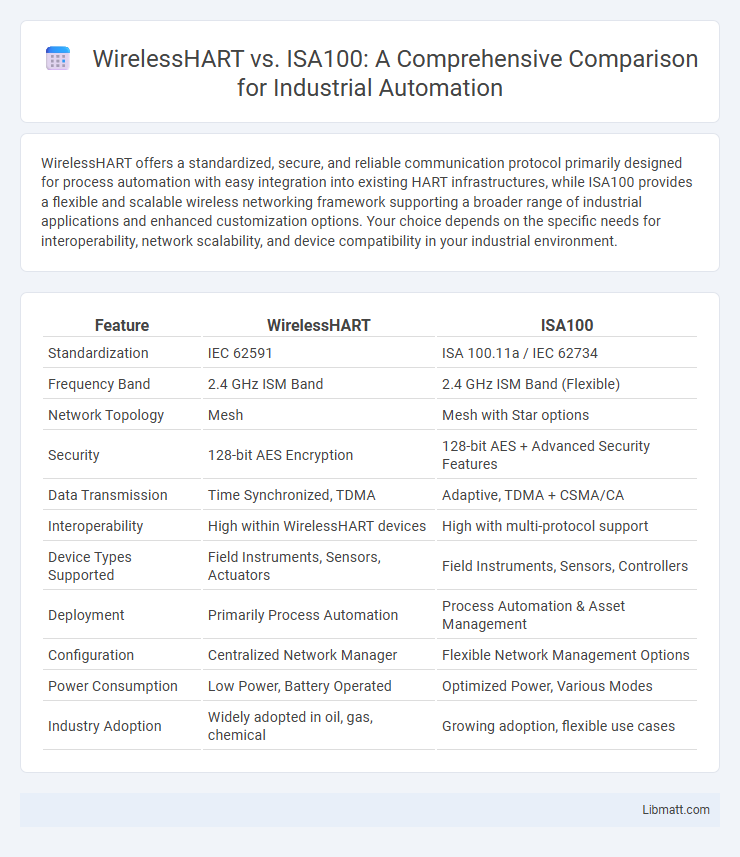WirelessHART offers a standardized, secure, and reliable communication protocol primarily designed for process automation with easy integration into existing HART infrastructures, while ISA100 provides a flexible and scalable wireless networking framework supporting a broader range of industrial applications and enhanced customization options. Your choice depends on the specific needs for interoperability, network scalability, and device compatibility in your industrial environment.
Table of Comparison
| Feature | WirelessHART | ISA100 |
|---|---|---|
| Standardization | IEC 62591 | ISA 100.11a / IEC 62734 |
| Frequency Band | 2.4 GHz ISM Band | 2.4 GHz ISM Band (Flexible) |
| Network Topology | Mesh | Mesh with Star options |
| Security | 128-bit AES Encryption | 128-bit AES + Advanced Security Features |
| Data Transmission | Time Synchronized, TDMA | Adaptive, TDMA + CSMA/CA |
| Interoperability | High within WirelessHART devices | High with multi-protocol support |
| Device Types Supported | Field Instruments, Sensors, Actuators | Field Instruments, Sensors, Controllers |
| Deployment | Primarily Process Automation | Process Automation & Asset Management |
| Configuration | Centralized Network Manager | Flexible Network Management Options |
| Power Consumption | Low Power, Battery Operated | Optimized Power, Various Modes |
| Industry Adoption | Widely adopted in oil, gas, chemical | Growing adoption, flexible use cases |
Introduction to WirelessHART and ISA100
WirelessHART and ISA100 are two leading industrial wireless communication protocols designed for process automation and control. WirelessHART, based on the HART Protocol, ensures robust, secure, and standardized mesh networking specifically optimized for field device communication. ISA100 offers a flexible and scalable wireless standard supporting diverse industrial applications with enhanced interoperability and wide device compatibility, giving your operations reliable wireless connectivity.
Overview of Industrial Wireless Standards
WirelessHART and ISA100.11a represent leading industrial wireless communication standards designed for process automation. WirelessHART, developed by the HART Communication Foundation, offers a robust, secure, and interoperable mesh network optimized for sensor-to-controller communication. ISA100.11a, created by the International Society of Automation, provides a flexible wireless platform supporting diverse protocols and device types, emphasizing scalability and enhanced network management in complex industrial environments.
Architecture Comparison: WirelessHART vs ISA100
WirelessHART features a standardized, layered architecture based on IEEE 802.15.4 with a time-synchronized mesh network ensuring reliable communication and backward compatibility across devices. ISA100 offers a more flexible and modular architecture supporting multiple communication protocols and customizable network configurations, enabling integration with legacy systems and diverse industrial applications. Understanding the architectural differences helps you select the optimal wireless sensor network for robust, scalable industrial automation environments.
Network Topology and Scalability
WirelessHART employs a mesh network topology that enhances reliability by enabling multiple communication paths between devices, supporting large-scale industrial environments with seamless scalability. ISA100 also utilizes a mesh network but offers greater flexibility in topology options, including star and tree configurations, allowing tailored network design to match specific application needs and improve scalability in complex systems. Your choice between WirelessHART and ISA100 should consider how each network's topology and scalability align with your facility's growth and communication reliability requirements.
Protocol Features and Data Communication
WirelessHART protocol features robust mesh networking, time-synchronized communication, and centralized security management, ensuring reliable and secure data transmission in industrial environments. ISA100 incorporates flexible network topologies with adaptive channel hopping and supports integration with legacy systems, enhancing interoperability and scalability. Data communication in WirelessHART relies on TDMA scheduling for deterministic timing, while ISA100 emphasizes real-time data exchange with provision for high-rate sampling and dynamic bandwidth allocation.
Security Mechanisms in WirelessHART and ISA100
WirelessHART employs robust security mechanisms including AES-128 encryption, mutual authentication, and frequency hopping to protect industrial wireless communications from eavesdropping and tampering. ISA100 also uses AES-128 encryption combined with configurable authentication and integrity checks, offering flexible security policies adaptable to varying industrial requirements. Your choice between WirelessHART and ISA100 should consider how these security features align with your specific industrial control system's protection needs.
Interoperability and Integration
WirelessHART offers strong interoperability with established HART devices and seamless integration into existing HART-based systems, ensuring compatibility across diverse vendors. ISA100 provides a more flexible framework supporting multiple protocols and device types, facilitating broader integration within complex industrial automation environments. Both standards emphasize secure, reliable communication, but WirelessHART's backward compatibility contrasts with ISA100's adaptive integration capabilities for evolving infrastructures.
Performance and Reliability Metrics
WirelessHART offers robust performance with deterministic communication and time-synchronized messaging, achieving low latency and high reliability through self-healing mesh networks that automatically reroute data around failures. ISA100 provides flexible network topologies with advanced security protocols and supports heterogeneous device integration, enhancing overall network scalability and fault tolerance. Both protocols aim for over 99.9% reliability, but WirelessHART's fixed time slots excel in applications requiring strict time synchronization, while ISA100's dynamic scheduling adapts better to varying traffic loads.
Industry Adoption and Use Cases
WirelessHART has widespread adoption in process industries such as oil and gas, chemical, and pharmaceuticals due to its robust mesh networking and straightforward integration with existing HART devices. ISA100 gains traction in complex plant environments like petrochemical facilities and power generation, favored for its flexible, scalable architecture and support for diverse application types beyond sensor monitoring. Both standards enable improved asset management and predictive maintenance, but WirelessHART's extensive installed base drives broader use in traditional industrial automation settings.
Future Trends in Industrial Wireless Standards
WirelessHART and ISA100 are evolving industrial wireless standards with future trends emphasizing enhanced interoperability and cybersecurity for Industry 4.0 applications. Both protocols are advancing toward integrating 5G and edge computing technologies to improve real-time data transmission and processing capabilities in smart manufacturing environments. The adoption of AI-driven network management and predictive maintenance tools is also shaping the future landscape of industrial wireless communication standards.
WirelessHART vs ISA100 Infographic

 libmatt.com
libmatt.com